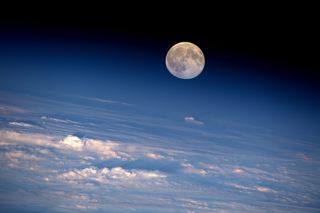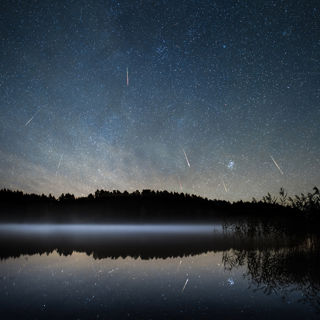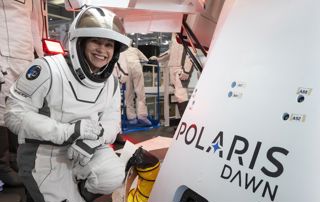
What's Happening in Space: August 2024
- 31st Jul 2024
- Author: Dhara Patel
A summary of space events through the month
Dhara Patel is a Space Expert at the National Space Centre, working to help share space science, stories, and topical news with our visitors and online audiences. Each month she curates a round-up of some notable space and science events coming up the weeks ahead.
There are some fascinating events coming up this August, including the peak of the Perseid meteor shower, a SpaceX launch and a blue moon...
4th August – new moon (12:13pm)
The new moon will occur in the constellation of Cancer. Without moonlight interference, it’s a great time to try and view deep sky objects. We have a blog on ‘phases of the moon’ written by Mike Darch in our Space Comms team: https://spacecentre.co.uk/blog-post/moon-phases/
5th August – Moon and Venus close in the sky
During the late evening of 5th August, the thin waxing crescent moon will be in conjunction (sharing the same right ascension – coordinate) with Venus, but the pair will be below the horizon at this time, so not visible from the UK. So instead try to catch the Moon and Venus in close proximity just after sunset in the west, when the pair will be just above the horizon. A clear view without tall buildings or trees that may block your view, will help you spot the pair more easily. The duo will be too widely separated to fit within the field of view of a telescope, but will be visible to the naked eye and possibly through a pair of binoculars together. Find out more about conjunctions and other astronomical phenomena in our blog written by David Southworth in our Education Team: https://www.spacecentre.co.uk/news/space-now-blog/astronomical-phenomena/.

12th/13th August – peak of the Perseid meteor shower
One of the best annual meteor showers, with ~ 100 meteors per hour at its peak, produced by dust left behind by Comet Swift-Tuttle. The shower peaks on the evening of 12th August into the early morning of 13th August. And with the moon in its first quarter phase it will fall below the south-western horizon by 11:00pm so there won’t be any moonlight interference after midnight. It’s still worth viewing from as dark a location as possible. The radiant will appear in the north-east rising higher into the sky as the night unfolds. Find an open location with clear views of the horizon and face north-east towards the radiant in the constellation of Perseus, but scan the entire starry canvas above, as meteors can appear anywhere in the sky. Find out more about the Perseid meteor shower 2024 in this blog written by Lucy Spencer in our Community team: https://www.spacecentre.co.uk/news/space-now-blog/perseid-meteor-shower-2024/
Image credit: Arnas Goldberg CC BY 3.0 DEED
14th August – Jupiter and Mars close in the sky
On the late afternoon of 14th August, Jupiter will be in conjunction (sharing the same right ascension – coordinate) with Mars, but the pair will be below the horizon at this time, so not visible from the UK. They will also be at their closest angular separation (close approach) just before but won’t be visible then as they begin to dip below the western horizon in the daylight. Instead try to catch Jupiter and Mars in close proximity just before sunrise in the east. Before sunrise on 14th August, Mars will sit just above Jupiter or at dawn on 15th August Mars will be slightly to the left of Jupiter. They’ll be high enough above the horizon, but a clear view without tall buildings or trees that may block your view, will help you spot the pair more easily. Jupiter will appear as the brighter point and Mars will have a slightly reddish hue. The pair will be close enough to fit within the field of view of a telescope but will also be visible to the naked eye or through a pair of binoculars. Check out the astronomical phenomena blog linked above to find out more about conjunctions and close approaches.
18th August – SpaceX Crew-9 launch
The ninth crewed operational flight of a Crew Dragon spacecraft to the International Space Station as part of NASA’s Commercial Crew Program includes NASA astronauts Commander Zena Cardman, Pilot Nick Hague, Mission Specialist Stephanie Wilson and Roscosmos cosmonaut Mission Specialist Aleksandr Gorbunov. They are scheduled to launch on board the Crew Dragon Freedom spacecraft atop a SpaceX Falcon 9 rocket from Kennedy Space Centre no earlier than 10:39am (UK time) on 18 August, although the launch window stretches into early September. This will allow the pad to be turned around for the Europa Clipper mission launch in October and fits with the overall sequence to undock and bring Wilmore and Williams home on Starliner, before launching the Crew-9 mission, and then bringing back Crew-8 (after handover). Having launched in March 2024, Crew 8’s Matthew Dominick, Michael Barratt, and Jeanette Epps of NASA, and Roscosmos cosmonaut Alexander Grebenkin will return to Earth on their Crew Dragon spacecraft, Endeavour, shortly after Crew-9’s launch, having completed a 6-month stint in space. Wilmore and Williams have been stranded on the ISS following their launch in early June on the new Boeing Starliner capsule, which experienced notable issues and is awaiting clearance to bring the astronauts home. Both SpaceX Crew Dragon and Boeing Starliner were contracted by NASA to take astronauts to and from the ISS – and while SpaceX have developed, tested, and been ferrying astronauts since 2020, Boeing are yet to complete a successful crewed flight and become operational.

19th August – full moon (7:25pm)
Known as the Sturgeon moon (according to the old Farmers’ Almanac), this full moon is named by North American fishing tribes who realised the sturgeon fish were abundant in this month. As the third full moon of four in this astronomical season (from the summer solstice to the autumnal equinox), this full moon is also a blue moon. Check out the “Full Moon: Full Facts” blog written by Mike Darch in our Space Comms team to find out more about full moons and blue moons: https://spacecentre.co.uk/blog-post/full-moon-facts/.
21st August – Moon and Saturn close in the sky / lunar occultation
In the early hours of 21st August, the waning gibbous moon will be in conjunction (sharing the same right ascension – coordinate) with Saturn and the pair will be at their closest angular separation (close approach) around the same time. From the UK, we’ll be able to see the Moon occult Saturn where the planet will slide behind the Moon disappearing from view completely, before reappearing on the other side a short time later. From Leicester, the occultation will begin with the disappearance of Saturn behind the Moon at 4:27am and its reappearance will be visible at 5:19am. Look to the southwest to catch the pair - they’ll be high enough above the horizon, but a clear view without tall buildings or trees that may block your view, will help you spot the pair more easily. They’ll be close enough to fit within the field of view of a telescope but can also be seen with the naked eye or through a pair of binoculars. Check out the astronomical phenomena blog linked above to find out more about conjunctions, close approaches and occultations.
Credit: NASA/Jeff Williams
27th August – Moon and Jupiter close in the sky
On the afternoon of 27th August, the waning crescent moon will be in conjunction (sharing the same right ascension – coordinate) with Jupiter, and pair will be at their closest angular separation (close approach) around the same time. However, in the daytime sky it won’t be possible to see Jupiter, so instead look for the Moon in close proximity to the gas giant planet in the predawn sky on that day. Look east before the Sun rises to see Jupiter tucked beneath the Moon, with Mars not too far away either. They’ll be high enough above the horizon, but a clear view without tall buildings or trees that may block your view, will help you spot the pair more easily. The Moon and Jupiter will be too widely separated to fit within the field of view of a telescope or a pair of binoculars, however they will be visible to the naked eye. Check out the astronomical phenomena blog linked above to find out more about conjunctions and close approaches.
28th August – Moon and Mars close in the sky
Shortly after midnight in the very early hours of 28th August, the waning crescent moon will be in conjunction (sharing the same right ascension – coordinate) with Mars, and the pair will be at their closest angular separation (close approach) a short time before conjunction too. They’ll be quite low on the northeastern horizon and although the Moon and Mars will be too widely separated to fit within the field of view of a telescope or pair of binoculars, they will be visible to the naked eye. Throughout the night the duo will rise higher into the sky making them easier to spot so you can still catch them in close proximity up until dawn. To increase your chances of spotting them, find an open location without tall buildings or trees that may block your view. Mars will have a reddish hue and will appear slightly dimmer than the other nearby brighter point of light – Jupiter. Check out the astronomical phenomena blog linked above to find out more about conjunctions and close approaches.

Late August ?? – Polaris Dawn mission
In this first mission of the Polaris Program, named Polaris Dawn, the four astronauts on board will achieve the highest Earth orbit by a crewed spacecraft since Gemini 11 in 1966. It will also attempt the first spacewalk by a private astronaut. Funded and commanded by the billionaire Jared Isaacman, the mission will be operated by SpaceX – using a modified crew dragon module and new EVA (Extra Vehicular Activity) spacesuits. The Polaris Dawn has been facing delays for the past two years and with astronauts Barry Wilmore and Sunita Williams awaiting return from the ISS after their Boeing Starliner vehicle experienced several issues on launch, there’s a lot going on with the ISS right now. So, Polaris Dawn has been postponed to late August, following the launch of SpaceX Crew 9, and is due to take off from Cape Canaveral Space Force Station, USA on a Falcon 9 rocket. Joining Isaacman will be pilot Scott Poteet, and mission specialists Sarah Gillis and Anna Menon. They will spend up to five days in orbit supporting scientific research designed to advance both human health on Earth and our understanding of human health during future long-duration spaceflight. And they’ll be the first to test Starlink laser-based communications in space. Find out more about the Polaris Dawn mission in this blog by Ed Turner in our Education team: https://www.spacecentre.co.uk/news/space-now-blog/polaris-dawn/
Image credit: Polaris Program
Late August?? – SpaceX Starship – Test Flight 5
Starship is made up of the Super Heavy booster – a first stage rocket with 33 of SpaceX’s raptor engines, and on top of that sits the upper stage - rather confusingly also called Starship (which hosts 6 engines). And when its fully developed, this launch vehicle will be a completely reusable rocket – both first and second stages. A modified version of Starship is currently planned to land astronauts on the Moon with the Artemis 3 mission.
- Test flight 5 is currently scheduled for some time in late August or early September from SpaceX’s launch facility, Starbase, in Boca Chica, Texas, United States. After the successful booster splashdown during the last test flight, Musk stated that on flight 5 he wants to attempt to catch the booster with the "chopstick" arms of Starbase's giant launch tower (to demonstrate reusability for the first time), but that is yet to be confirmed.
Find out more about Starship and SpaceX’s other rocketry achievements in this blog by Ed Turner in our Education team: https://www.spacecentre.co.uk/news/space-now-blog/spacex-the-world-s-rocket-giant/
Please note: As this summary is created at the end of the month before, dates (especially launch dates) can often change or be updated, so this content may become outdated - we always recommend checking on the relevant organisation's pages.
